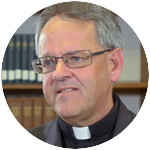
Father Thomas Dailey, O.S.F.S.
The tragic events in Sri Lanka have raised an interesting question for people of faith everywhere. With Sunday Masses there having been canceled for a second week due to ongoing security concerns, what does it mean to be the church if the faithful cannot gather in a church?
To provide for the faithful, the archbishop, Cardinal Malcolm Ranjith, celebrates Mass at his residence, which is televised for all to view. In our electronic environment, does this constitute “going” to church? Might we conceive of the church as a “network” of the ecclesial kind, akin to the social networks so prominent in today’s digital world?
Pope Francis offers a response to the latter question in this year’s Message for the World Day of Communications. That papal text explores the theme of moving “From social network communities to the human community.” Its final sentence claims: “The Church herself is a network woven together by Eucharistic communion, where unity is based not on ‘likes,’ but on the truth, on the ‘Amen,” by which each one clings to the Body of Christ, and welcomes others.”
[hotblock]
For the Holy Father, the metaphorical understanding of church as a network is grounded on the Pauline assertation that “we are members one of another” (Ephesians 4:25). This kind of membership far exceeds the voluntary association characteristic of most organizations. Instead, it speaks to a faith-based unity in diversity, the former centered on Jesus Christ, the latter reflecting the distinct persons who believe in him.
This notion of community, says Pope Francis, reflects “our being created in the image and likeness of God who is communion and communication-of-Self.” Personal faith in a Trinitarian God is, itself, a relationship. As a consequence of this dynamic encounter, “and under the impetus of God’s love,” solidarity in faith unites believers in an act of welcoming, understanding, and responding to each other in the charity that is Christianity’s hallmark.
To speak of the church as an ecclesial “network” expresses this sense of religious community in terms redolent of today’s social media. Like the image of a virtual “commons” or online hub (think: Google hangout), this model appreciates the connectedness of a catholic (i.e., universal) church. Through the global reach of digital technology, it can also serve the church’s universal mission of “making disciples of all nations” (Matt 28:19).
[tower]
But the network model poses serious questions in terms of belonging to a church. Do people connected online actually encounter one another as fellow believers? That may be difficult in front of a screen at home, but neither does it happen simply through proximity in a pew at church.
Are believers joined through the internet truly committed to their church community? Geographical distance potentially lessens the linkage, but so does a lack of intentionality among those present at liturgies in a church.
Church-goers rarely consider it, but what they do each week in worship entails multiple modalities of human action. They see and are seen together. They speak and hear, in words and songs. They relate to and interact with fellow believers. They “actively participate” in the liturgical action by attending to, and intending with, what’s going on.
Through the marvels of digital technology, these actions can now happen online, even if to a lesser degree. The physical space may not be shared, but the spiritual space can be.
In fact, the notion that presence can be mediated in absence lies at the heart of every liturgy. Through sacred rituals, the graced presence of Jesus is manifest in sensible ways, not unlike how the risen Lord was made known to the disciples on the road to Emmaus.
As theologian Louis-Marie Chauvet explains, “In his absence, his presence prevails as a living memory in and through the Church; the Church mediates this presence through word, sacrament, and ethical action.”
At every Mass, God’s presence is mediated to us through liturgical modalities. We believe Jesus remains with us in his biblical Word, in the minster who acts “in persona Christi,” in the assembly of believers who gather in his name, and in the bread and wine that become his body and blood in the Eucharist.
Digital transmission adds a layer of mediation to the fundamental work of the church. Far from ideal, it nevertheless provides some real share in our eucharistic communion with God and fellow believers when being together in-person is rendered impossible. Even online we can cling to the Body of Christ as members of one another.
***
The papal message for World Communications Day will be discussed with Bill McGurn, of the Wall Street Journal, during the John Cardinal Foley Symposium at St. Charles Borromeo Seminary on May 23 at 7 p.m. All are invited.
For more information, visit the website at www.scs.edu/cardinal-foley-symposium.
***
Father Dailey is the John Cardinal Foley Chair of Homiletics and Social Communications at St. Charles Borromeo Seminary, Wynnewood, and a research fellow for the Catholic Leadership Institute in Wayne.
PREVIOUS: Lawmaker’s rant shows we are among wolves
NEXT: Young man’s answer to ‘what is church?’ is revealing, hopeful



Share this story